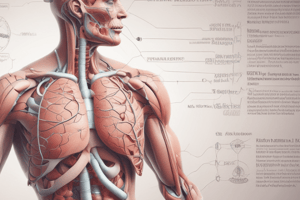Podcast
Questions and Answers
What is the primary function of the diaphragm in the respiratory system?
What is the primary function of the diaphragm in the respiratory system?
- To filter the air we breathe
- To regulate pH levels in the body
- To separate the chest cavity from the abdominal cavity
- To help expand the lungs during inhalation (correct)
Which organs are responsible for exchanging oxygen and carbon dioxide?
Which organs are responsible for exchanging oxygen and carbon dioxide?
- Diaphragm and Rib Cage
- Trachea and Bronchi
- Lungs (correct)
- Nose and Mouth
What happens to the air pressure in the lungs during inhalation?
What happens to the air pressure in the lungs during inhalation?
- It remains the same
- It decreases (correct)
- It increases
- It is not affected
What is the role of the bronchi in the respiratory system?
What is the role of the bronchi in the respiratory system?
What is the main function of the respiratory control center?
What is the main function of the respiratory control center?
What is the fate of oxygen in the body after it is inhaled?
What is the fate of oxygen in the body after it is inhaled?
What is the primary function of the nose and mouth in the respiratory system?
What is the primary function of the nose and mouth in the respiratory system?
What happens to the diaphragm during exhalation?
What happens to the diaphragm during exhalation?
Flashcards are hidden until you start studying
Study Notes
Functions of the Respiratory System
- Brings oxygen into the body
- Removes carbon dioxide from the body
- Regulates pH levels by removing excess hydrogen ions
- Helps to filter the air we breathe
- Provides a sense of smell
Organs of the Respiratory System
- Nose and Mouth: air enters the body through the nose or mouth
- Trachea: tube that connects the nose and mouth to the lungs
- Bronchi: tubes that branch off from the trachea and lead to the lungs
- Lungs: organs responsible for exchanging oxygen and carbon dioxide
- Diaphragm: muscle that separates the chest cavity from the abdominal cavity and helps to expand the lungs
- Rib Cage: protects the lungs and helps to expand the chest cavity
Mechanism of Breathing
- Inhalation:
- Diaphragm contracts and flattens
- Rib cage expands
- Air pressure in the lungs decreases
- Air enters the lungs through the nose or mouth
- Exhalation:
- Diaphragm relaxes and rises
- Rib cage descends
- Air pressure in the lungs increases
- Air leaves the lungs through the nose or mouth
Gas Exchange
- Oxygen:
- Enters the lungs through inhalation
- Diffuses into the bloodstream through the alveoli
- Bound to hemoglobin in red blood cells
- Transported to cells throughout the body
- Carbon Dioxide:
- Produced by cells throughout the body
- Transported to the lungs through the bloodstream
- Exhaled out of the body through the nose or mouth
Respiratory Control Center
- Located in the brainstem
- Regulates breathing rate and depth
- Responds to changes in CO2 levels and pH levels in the blood
- Can be influenced by emotional state, stress, and other factors
Functions of the Respiratory System
- Brings oxygen into the body and removes carbon dioxide
- Regulates pH levels by removing excess hydrogen ions
- Helps to filter the air we breathe
- Provides a sense of smell
Organs of the Respiratory System
- Air enters the body through the nose or mouth
- The trachea is a tube that connects the nose and mouth to the lungs
- Bronchi are tubes that branch off from the trachea and lead to the lungs
- Lungs are responsible for exchanging oxygen and carbon dioxide
- The diaphragm is a muscle that separates the chest cavity from the abdominal cavity and helps to expand the lungs
- The rib cage protects the lungs and helps to expand the chest cavity
Breathing Process
- Inhalation occurs when the diaphragm contracts and flattens, the rib cage expands, and air pressure in the lungs decreases
- During inhalation, air enters the lungs through the nose or mouth
- Exhalation occurs when the diaphragm relaxes and rises, the rib cage descends, and air pressure in the lungs increases
- During exhalation, air leaves the lungs through the nose or mouth
Gas Exchange Process
- Oxygen enters the lungs through inhalation, diffuses into the bloodstream through the alveoli, and binds to hemoglobin in red blood cells
- Oxygen is transported to cells throughout the body
- Carbon dioxide is produced by cells throughout the body, transported to the lungs through the bloodstream, and exhaled out of the body through the nose or mouth
Respiratory Control Center
- The Respiratory Control Center is located in the brainstem
- It regulates breathing rate and depth
- The center responds to changes in CO2 levels and pH levels in the blood
- It can be influenced by emotional state, stress, and other factors
Studying That Suits You
Use AI to generate personalized quizzes and flashcards to suit your learning preferences.




